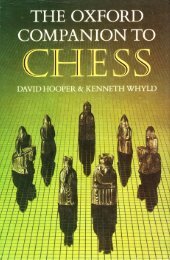You also want an ePaper? Increase the reach of your titles
YUMPU automatically turns print PDFs into web optimized ePapers that Google loves.
CONTROI- NOTATION 77<br />
eration is theire.eate. potential mobilily. Central A task remrd <strong>by</strong> tbe English .omposer H.rold<br />
10 pHxDoR's teaching is the ide. rbar connecred Horeate Crc$ (1909 {2), Pioble irt Fairy Supptepasns<br />
<strong>to</strong>gelherhave adynamisn grearer than the D.,r. 1936. Wnite has 29 lorced mates in o.e (i.e.<br />
sum ofthe partsi that such pawns may become a ,o moves ihat do nol give nate) in a leSal Posnion<br />
sr.atesic (positional) rorce in thenselyes.<br />
without obrusive piees.<br />
lnteresl in const ructi on t as ks was .eawaken ed b y<br />
coNsoLIDATIoN. lhe slabilization oi a<br />
DaNson aroufld 1911 and duling lhe lollowing<br />
loose<br />
years<br />
posilion. For ex.nple, a player gains he both enouraged comPosers and sug<br />
material, but<br />
gested<br />
thc cflort leavcs his pie.es $atleredi<br />
ne* tasls. ln 1938 thc pub,ication of his<br />
he consolidales<strong>by</strong>bnngingthemback<br />
i.<strong>to</strong>play(i.e.<br />
book Ubimate <strong>The</strong>rus inspited many conposers,<br />
heseeks<br />
.o-oPturloN) as a preparatiotr<br />
the most su@esstul ol *hon was PEnoua: about<br />
<strong>to</strong>r 1he exploitation<br />
ol his nalenal advantase. (For exanples lro6 play ten of the lasks he achierd in the 1940s have<br />
remained unbedten. Anolher husl ol adivity<br />
SEC AI-EXAND'R ANd UNZ]'(ER,)<br />
CONSTRUCTION TASK, a position constructcd CONSULTATION CAMD, agamc inwni.h oneor<br />
<strong>to</strong>showarAs(forwhichthe play is elementary. (A both sides @nsist oI tso or mo.e players in<br />
posilio. Lom shich ihere is no play is called an<br />
AmNGEMENT.) rhe conposer displays his aares:<br />
rhere is nolhing for the solver 10 do. One kind of CONTROL. A player Nould conlrol or have<br />
taskwouldbe<strong>to</strong>shosthelargeslpossiblenumber control of a square if he werc able lo caplure<br />
of keys for, sar, a lwo-moveri but nost t6ks advanlageously any of the opponenfs nen lhat<br />
requne one single nove <strong>to</strong> be nade, <strong>by</strong> one or might bc moved there Ilpiaybeganld4d6 2NR<br />
botn sidcs. and thesc arc callcd one-movcr construciion<br />
tasks, or one-moveEi and ihe idea is <strong>to</strong> Blact play 2. . . e5: but if whitc comnenced I<br />
White would on<strong>to</strong>l e5, Ninning a pawn should<br />
show rhe largest or sballest nuober of noves ot NB Nl6 2 bl d6 3 Bb2 ne would not cotrirol e5<br />
one type, e.g. checks or caplures. <strong>The</strong>re are although itisattacked<strong>by</strong>tNo nen and defended <strong>by</strong><br />
'forced' rorms (inlroduccd <strong>by</strong> DAwsoN in 1913) onei Black could salely rePly 3 . . . e5. Thus<br />
when every possible single-move musr contribure effective onlrol depends upon both thc number o{<br />
<strong>to</strong> the t.sk i the position nay be legal or ilegal, witb men involved and thcn relative value<br />
or without oBmusrE pEcEs. with or withour A player.ontroh a file, rank, or diaeonal when<br />
prooorio. in play. Conventionally, the orthodox one ol his line pieces auacks all or mosr oI tne<br />
boa.d and men are used, but one-moven have squares on that line andvhcn hh oppoaent cannol<br />
been aitempGd in the iairy realn. <strong>The</strong> lollowin8 expediently defend <strong>by</strong> opposing a suitable line<br />
positions, given in roRsm NorAnoN, aie the tso piece. To control a line does nor imply thal all tne<br />
tasts that halc remaincd unbcatcn for thc longcsr squares on the line are separately.ontrolledi only<br />
that lhe line piece h6 thcm under suneillance.<br />
82R5/k2N4/6R1/3BBN2/1O6/lK4/8, This. rhe (See sMyslo! foragame inwhich BlacksaqiEces<br />
earliest known one dover, was obposed <strong>by</strong> the hn queen <strong>to</strong> gain decisive con<strong>to</strong>l of borh long<br />
GerFan Md Bezeu (1824-71), and published in_<br />
S.ruruen"z8,1849; it showsthe maximum number<br />
of novs ( 100) tbar can be nade wirh the eisht enrre. which may mca. no nore ihan tbeontrol<br />
Inrheopeningaplayertricslo gain conrrololthe<br />
of the greater number of central squares. It he<br />
4NlrUP2IK2P/8/lP1kBQ2,2Ri/181N,1/4P.3/3R4 achieves this, he f.ins space in the ccnrr., a<br />
A composition <strong>by</strong> Bezzel a.d loui othem, 1116' synonvmous tcrm control of central squares is<br />
t.irr. Z.rr!,8. 1859: il shoNs 47 nales in one using a Ircqucntly bnt noi necessanly advanlageous. (See<br />
ttcAl posltionwithoui obtrusivepieces. (Another vAcANlAr lor a gane in Bhich Black nakes a<br />
positio. showing 4, mates, but using morc mcn. decisive sacnlice on lbe lery squlre in the cenrrc.<br />
was Published at tbe same iime.) e5, rhal While sccms lo hale nost 6mly under<br />
CONTROL NOTATION, a name used in somc<br />
coudties <strong>to</strong>r the sinplest mcthod of describing a<br />
position. Sia ing aith the Nhite men each manis<br />
named and thesqua.eonwhicbilstandsidentilied.<br />
<strong>The</strong> squares nay be nam.d <strong>by</strong> standard or<br />
descripiive ncthods. bul the lomer is more<br />
.ommonly used. <strong>The</strong> sMvEDu study. ior ex<br />
<strong>amp</strong>le. would b e de scribed as folloNs:While Kb6.<br />
Pc6i Black Kat- Rd5. Conirol notation is besl<br />
suiled ro posirionswith fes men on lhe board. <strong>The</strong><br />
altcinatilc, roRslrH Nor^noN. is perhaps biased




